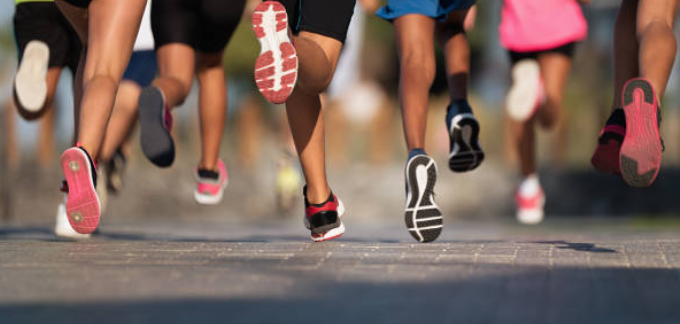The Relationship Between Physical Literacy and Moderate to Vigorous Physical Activity Among Children 8-12 Years

Previously published in Volume 84, Issue 4
Abstract
Purpose: This study investigated whether objectively measured moderate-to-vigorous physical activity (MVPA; minutes/day collected via pedometers) could be predicted from physical literacy (PL) in children aged 8 to 12. Methods: One-way analysis of variances (ANOVAs) were used to compare differences in descriptive statistics. Five Multiple Linear Regressions (MLRs) were used to determine if objectively measured age, gender, and the overall Canadian Assessment of Physical Literacy (CAPL) scores (and the four domains) could predict MVPA Results: Each model statistically predicted MVPA from the overall CAPL score and all four domains, age, and gender. MVPA was statistically associated with CAPL score (p < .001), Daily Behavior score (p < .001; objectively measured via pedometers and subjectively measured via three self-reported questions), Physical Competence score (p = .001), and Motivation and Confidence score (p < .001). MVPA was not statistically significantly associated with Knowledge and Understanding (p = .165). Conclusion: PL scores were associated with MVPA accumulated through pedometer usage (minutes/day), in addition to Daily Behavior, Physical Competence, and Motivation and Confidence. Future research is warranted that accounts for the various limitations within the current study, in addition to other correlates that may influence physical activity and/or PL.
Introduction
Numerous health benefits are associated with physical activity (Janssen & LeBlanc, 2010) including the physical aspects relating to decreased risk for cardiovascular and/or metabolic diseases (Hatfield & Chomitz, 2015). Psychosocial aspects are also important, such as increased happiness, increased development of social skills, reduced symptoms of depression among adolescents (Hüttenmoser, 1995; McPhie & Rawana, 2015; Richards et al., 2015), and cognitive health aspects among children (e.g., increased academic performance for memory and ability to learn; Becker, McClelland, Loprinzi, & Trost, 2014; Domazet et al., 2015). However, only 14% of Canadian children 5 to 11 years of age and 9% of children 5 to 17 years of age are achieving the recommended levels of physical activity based on Canadian physical activity guidelines (Colley et al., 2017; Statistics Canada, 2015). The current Canadian 24-Hour Movement Guidelines encourages children (aged 5–17 years) to Sweat, Step, Sleep, and Sit, with the goal to increase physical activity, decrease sedentary behaviors, and maintain sufficient sleep each day for optimal health benefits (Canadian Society for Exercise Physiology (CSEP), 2016). Under the Sweat portion of the guidelines, children should engage in 60 minutes of moderate to vigorous physical activity (MVPA) daily. Poitras et al. (2016) suggested that participation in MVPA is vital for disease prevention and health promotion.
It is thought that the low level of MVPA among Canadian children may be associated with physical literacy (PL; Longmuir & Tremblay, 2016). Recently, a national study of PL in Canadian children (aged 8-12; N = 10, 034) was conducted (Tremblay et al., 2018). Eleven geographically dispersed study sites (and their coordinating centres) across in Canada were selected to participate in the study, with sites ranging as far west as Victoria, British Columbia, and as far east as Halifax, Nova Scotia (Tremblay et al., 2018). The results of this study suggested that the majority of children are not achieving adequate levels of PL, with most participants being categorized as progressing (i.e., 2nd out of 4 stages of PL; Tremblay et al., 2018). According to Whitehead (2010), PL is having the motivation, knowledge and understanding, confidence, and physical competence in order to maintain a physical active lifestyle throughout life, in addition to having the ability to effectively interact with the physical environment. Therefore, PL can also be thought of as the ability to achieve the fundamental movement skills for object control (e.g., catching), locomotor skills (e.g., running), stability skills (e.g., balancing), and to possess the motivation and confidence as well as the knowledge and understanding of physical activity (Giblin, Collins, & Button, 2014; Lander, Eather, Morgan, Salmon, & Barnett, 2017). It is generally thought that the more physically literate a child is, the more likely they will be able to perform a variety of movements confidently, competently, creatively, and strategically across a wide range of health-related physical activities (Longmuir et al., 2015). A recent study among Canadian children suggested that those with higher levels of physical competence and motivation and confidence for physical activity were more likely to meet the physical activity and sedentary guidelines set forth by CSEP (Belanger et al., in press). However, the need to use objectively measured physical activity data, rather than subjective data (as in the case of Belanger et al, in press), has been argued among many researchers (Adamo, Prince, Tricco, Connor‐Gorber, & Tremblay, 2009; Dyrstad, Hansen, Holme, & Anderssen, 2014; Götte, Seidel, Kesting, Rosenbaum, & Boos, 2017). Therefore, the objective of this study was to build upon Belanger et al. (in press) to investigate whether objectively measured MVPA (minutes/day collected via pedometers) could be predicted from PL. It was hypothesized that those with higher PL would spend more time in MVPA.
Methods
Participants
Approximately 1,300 children (ages 8-12 years) from southwestern Ontario were recruited via summer/day camps (both paid and unpaid non-sport specific camps; offered through municipalities and various YMCA’s of Southern Ontario) and from schools. All protocols were completed in English or French, depending on the site. Participation in this study was strictly on a voluntary basis, where informed written consent from the parent or guardian, along with verbal assent of the child, was obtained. Testing sessions took place during camp/school hours and took approximately two hours to complete all protocols (including the survey). Upon completion of the battery of measures, pedometers were handed out and returned 5-7 days later to the testing site for pick up by the research team.
Protocol and measurements
This study was approved by the University of Windsor’s Research Ethics Board. Data collection occurred between 2014-2016 and took approximately two hours to administer all protocols. The Canadian Assessment for Physical Literacy (CAPL) was used to measure PL which was administered via trained research staff. Data were collected for each of the four CAPL domains (Physical Competence, Daily Behavior, Motivation and Confidence, and Knowledge and Understanding) which are combined into an overall score. The overall CAPL score is out of 100, with Physical Competence and Daily Behavior each yielding 32 points, and the Motivation and Confidence and Knowledge and Understanding scores making up 18 points each. Please refer to Tremblay et al. (2018) for a breakdown of measurement protocols and scoring. Upon competition of all protocols, pedometers were handed out and returned 5-7 days later to the testing site for pick up by the research team.
Data treatment and Statistical analyses
Data treatment. PiezoRX pedometers were used for the current analysis study (StepsCount, 2017). Only participants that met the inclusion criteria for pedometer usage (i.e., acquired 1,000 to 30,000 steps/day, worn for a minimum of ten hours, and had a minimum of three days) were included in the present analysis. Time spent in moderate and vigorous physical activity were measured as >110 steps/minute and >130 steps/minute, respectively (Saunders et al., 2014). MVPA (minutes/day) was calculated based on the average amount of time (minutes) spent in moderate and vigorous physical activity.
The Daily Behaviour score is normally out of 32 points, with objectively measured average daily step count via pedometers accounting for 21 points, self-reported sedentary time being attributed 8 points, and self-reported number of days a week a child engages in MVPA accounting for the remaining 3 points. A new Daily Behaviour score was calculated for the current study by removing the objectively measured step count (21 points) and the self-reported number of days a week a child engages in MVPA, leaving a score out of 8 points, attributed only to self-reported sedentary time. In order to maintain the correct weighting of the Daily Behavior score within the overall CAPL score calculation itself, the new 8 point Daily Behaviour score (now consisting only of self-reported sedentary time out of 8 points) was prorated back to a score out of 32 points.
Statistical analyses. Data collected from the study were analyzed using SPSS version 24.0 for Windows (IBM Corp., 2016). All assumptions for the statistical analyses were met and all tests were deemed significant at p < 0.05. Descriptive statistics for the overall CAPL score, domain scores, and MVPA scores were calculated as means and standard deviations for participants, stratified by both age and gender. One-way ANOVAs were used to compare differences in descriptive statistics. Five Multiple Linear Regressions were used to determine if objectively measured age, gender, and the overall CAPL scores (and the four domains) could predict MVPA (minutes/day collected via pedometers).
Results
Across southwestern Ontario, 1,278 children (ages 8-12 years) participated, yet the data for 219 participants were excluded for not meeting the acceptable criteria for pedometer usage, leaving 1,059 participants for the analysis. There were no differences between those excluded (vs. included) based on gender (p = 0.172), however, more 9 and 12 year old’s were excluded than 8, 10, and 11 year old’s (p = 0.004). The descriptive statistics for the overall CAPL score, domain scores, and MVPA (time/day) of participants, stratified by age and gender are provided in Table 1.
Girls had significantly higher overall PL scores than boys, F(1, 1025) = 6.300, p = .012, w2 = .005, but boys had significantly greater levels of MVPA than girls, F(1, 1057) = 37.183, p < .001, w2 = .033. While there were no significant difference in the overall CAPL score based on age, however, significant differences in MVPA based on age existed, F(4, 1054) = 7.81, p < .001, w2 = .025. Tukey post hoc analyses revealed that while 9 year old’s had statistically the same number of minutes of MVPA as 12 year old’s, they (i.e., 9 year old’s) had significantly more minutes of MVPA than 8 (p = .029), 10 (p = .015), and 11 (p = < .001) year old’s.
Data from the Multiple Linear Regression models are presented in Table 2. Each model statistically predicted MVPA from the overall CAPL score and all four domains, age, and gender. MVPA was statistically associated with CAPL score (p < .001), Daily Behavior score (p < .001), Physical Competence score (p = .001), and Motivation and Confidence score (p < .001). MVPA was not statistically significantly associated with Knowledge and Understanding (p = .165). Lastly, although all regression models statistically predicted MVPA, R2 values (as found in Table 2) were all considered negligible (< .2).
Discussion
The current study provides evidence that overall PL is associated with MVPA, including Physical Competence, Motivation and Confidence, and Daily Behavior but not Knowledge and Understanding. The relationship between MVPA and overall PL reported in this study supports previous research by Longmuir and Tremblay (2016) who proposed that low levels of MVPA in Canadian children may, in part, be due to low levels of PL. Moreover, the significant association between MVPA and overall PL, as well as with three of the four domains, potentially suggests that the more children engage in activities that increase both breathing and heart rate, the more likely they are to be physically literate. However, further investigation is warranted on the potential associations between MVPA and PL. While statistically significant associations were reported, the practical significance of these findings needs to be examined as the effect sizes were negligible.
Moreover, the current study also suggests that MVPA is individually associated with Physical Competence, Motivation and Confidence, and Daily Behavior. These results are supported by a study by Belanger et al. (2018) who suggested that children are more likely to meet Physical Activity guidelines (which are based on a subjective measure of time spent in MVPA) if they have higher Physical Competence and Motivation and Confidence scores. Similarly, as children progress into adolescence, high levels of perceived motor competence (i.e., high motivation and confidence levels) are reported to be associated with higher levels of physical activity in comparison to those who perceived their motor competence to be low (i.e., low motivation and confidence levels; An De Meester et al., 2016). Silverman and Mercier (2015) also conducted a review of the associations between motor skill learning and student’s attitudes and noted that student attitudes are correlated with participation in physical education classes (i.e., if students are motivated, they are more likely to actively participate in physical education class), further supporting the results of the current study.
The association between MVPA and Physical Competence is not entirely surprising, as Physical Competence (associated with motor skills and physical fitness), along with the ability and implementation of fundamental movement skills, have been reported as being strong predictors of children’s ability to be physically active and literate throughout their life course (Longmuir et al., 2015; Simpson et al., 2017). Also, the association between MVPA and Motivation and Confidence reported in the present study provides additional support to Tremblay and Lloyd (2010) who propose that individuals who have the motivation to be physically active and the confidence in their physical abilities are more likely to be physically active throughout their life and maintain higher levels of MVPA. Furthermore, MVPA was reported to be associated with the recalculated Daily Behavior score (a score that now only includes self-reported sedentary time). This complements the research of Ekelund et al (2012) who also demonstrated associations between time spent in MVPA and time spent sedentary, with the higher amounts of time spent in MVPA leaving less time to be spent being sedentary.
Although previous research suggests that at the age of 6 years, Knowledge and Understanding of physical activity becomes a strong determinant of children’s physical activity levels later in life (DiLorenzo, Stucky-Ropp, Vander Wal, & Gotham, 1998), the current findings indicated that there was no relationship between Knowledge and Understanding and time spent in MVPA. Conversely, Bandura (1991) proposes that while an individual may have the Knowledge and Understanding regarding the benefits of engaging of a behavior, in this case engaging in MVPA, they may still choose not to engage in this behavior. As such, whether or not a child in the current study engaged in high levels of MVPA or not may not be indicative of their level of Knowledge and Understanding in regards to the importance of engaging in MVPA.
Finally, the ease of using MVPA collected from pedometers and the observed associations between MVPA and PL may provide support of using objectively measured MVPA within the scoring of the CAPL protocol. The use of objectively measure MVPA would provide a more accurate and reliable result (Adamo et al., 2009; Dyrstad et al., 2014; Götte et al., 2017), compared to a subjective survey question, without any significant costs as many pedometers (which are already needed to track step count) already have the ability to measure MVPA, like the ones utilized in this study. Therefore, it is suggested that CAPL consider the addition of objectively measured MVPA in their scoring process to strengthen their measure of PL or replacing the subjective measure of MVPA altogether.
Limitations
This study is not without limitations. There are numerous factors that can be attributed to a child’s participation in physical activity, such as socioeconomic status (Elgar et al., 2015), safety attributed to outdoor play (Faulkner, Mitra, Buliung, Fusco, & Stone, 2015), active transportation (Tremblay et al., 2015), and through sport participation (Marquesa, Ekelund, & Sardinhaa, 2016), all of which were not factored in to the current study. Although location of the data collection (urban, rural, and suburban) was collected, it was not entered into the CAPL score and it is suggested that a measure of socioeconomic status be incorporated in the future. Secondly, the participants of this study were obtained via a convenience sample. The participants were recruited from summer/day camps and schools. The recruited children could have been predisposed to participation in physical activities because of the availability to become active was encouraged through organized programming or physical education class. Perhaps a more randomized sample could provide a better representation of physical activity and PL in southwestern Ontario. Moreover, the effect sizes for all analyses performed in this study are negligible. As such, more research is needed to determine its true practical significance. Lastly, in relation to the PiezoRx pedometer model used to collect MVPA, there were some challenges that arose with respect to the functionality. Some of the pedometers malfunctioned or the battery died while the participant used the pedometer. Additionally, as MVPA was measured with step frequency (per minute), some non-weight bearing activities (e.g., riding a bike) and/or water-related activities (e.g., swimming) were not accounted for. Lastly, determining the maturation (puberty status) of participants was beyond the scope of this study, but could be a potential variable to consider in future studies.
Implications and Conclusions
Overall, the main objectives of this study were to determine whether MVPA could be predicted by PL among children 8 to 12 years of age in southwestern Ontario. Overall PL scores were associated with MVPA accumulated through pedometer usage (minutes/day), in addition to Daily Behavior, Physical Competence and Motivation and Confidence. Future research is warranted that accounts for the various limitations within the current study, in addition to other predictors that may influence physical activity and/or PL.
What this article adds
Although theoretical constructs suggest that those with low PL will not engage in physical activity, limited empirical evidence exists. Therefore, along with Belanger et al. (2018), this initial evidence suggests that those specifically with higher physical competence, motivation and confidence, and lower sedentary behavior, which are several concepts within PL, will engage more in MVPA. The unique aspect of the current study was that MVPA was measured objectively through the use of pedometers, rather than subjective measures, which are known to have social desirability bias and recall errors. As such, while determining ways to increase PL is a current topic of discussion amongst researchers, this study provides further evidence of its importance by providing initial empirical evidence of its association with MVPA. Lastly, increasing PL both inside and outside of physical education classes is becoming an increasingly important area of concern for practitioners (e.g., physical education teachers). As such, the results of this study provides preliminary evidence that practitioners may positively influence MVPA and, thus, PA inside and outside of the gymnasium, by creating environments that promote the development of positive student attitudes (i.e., motivation and confidence), encouraging students to reduce their daily sedentary time (i.e., daily behaviour), and/or providing instruction that continues to increase students’ physical competencies. Small changes in any or all of these areas could have big reward for children/students MVPA.
References
Adamo, K., Prince, S., Tricco, A., Connor‐Gorber, S., & Tremblay, M. (2009). A comparison of indirect versus direct measures for assessing physical activity in the pediatric population: A systematic review. International Journal of Pediatric Obesity, 4(1), 2-27.
De Meester, A., Maes, J., Stodden, D., Cardon, G., Goodway, J., Lenoir, M., & Haerens, L. (2016). Identifying profiles of actual and perceived motor competence among adolescents: associations with motivation, physical activity, and sports participation. Journal of Sports Sciences, 34(21), 2027-2037.
Bandura, A. (1991). Social cognitive theory of self-regulation. Organizational Behavior and Human Decision Processes, 50(2), 248-287.
Becker, D., McClelland, M., Loprinzi, P., & Trost, S. (2014). Physical activity, self-regulation, and early academic achievement in preschool children. Early Education and Development, 25, 56–70. doi:10.1080/10409289.2013.780505
Belanger, K., Barnes, J. D., Longmuir, P. E., Anderson, K. D., Bruner, B., Copeland, J. L., … Tremblay, M.S. (2018). The relationship between physical literacy scores and adherence to Canadian physical activity and sedentary behavior guidelines. BMC Public Health.
Canadian Society of Exercise Physiology. (2016). Canadian 24-hour movement guidelines for children and youth: An integration of physical activity, sedentary behavior, and sleep [PDF file]. Retrieved from http://www.csep.ca/CMFiles/Guidelines/24hrGlines/Canadian24HourMovementGuidelines2016.pdf
Colley, R. C., Carson, V., Garriguet, D., Janssen, I., Roberts, K. C., and Tremblay, M. S. (2017). Physical activity of Canadian children and youth, 2007 to 2015. Health Reports, 28(10), 8-16.
DiLorenzo, T. M., Stucky-Ropp, R. C., Vander Wal, J. S., & Gotham, H. J. (1998). Determinants of exercise among children. II. A longitudinal analysis. Preventive Medicine, 27(3), 470-477.
Domazet, S., Tarp, J., Huang, T., Gejl, A., Andersen, L., Froberg, K., & Bugge, A. (2016). Associations of physical activity, sports participation and active commuting on mathematic performance and inhibitory control in adolescents. PLoS One,1 (1), 1-12. doi:10.1371/journal.pone.0146319
Dyrstad, S. M., Hansen, B. H., Holme, I. M., & Anderssen, S. A. (2014). Comparison of self-reported versus accelerometer-measured physical activity. Medicine & Science in Sports & Exercise, 46(1), 99-106.
Ekelund, U., Luan, J. A., Sherar, L. B., Esliger, D. W., Griew, P., Cooper, A., & International Children's Accelerometry Database (ICAD) Collaborators. (2012). Moderate to vigorous physical activity and sedentary time and cardiometabolic risk factors in children and adolescents. Journal of the American Medical Association, 307(7), 704-712.
Elgar, F. J., Pförtner, T. K., Moor, I., De Clercq, B., Stevens, G. W., & Currie, C. (2015). Socioeconomic inequalities in adolescent health 2002–2010: A time-series analysis of 34 countries participating in the Health Behavior in School-aged Children study. The Lancet, 385(9982), 2088-2095.
Faulkner, G., Mitra, R., Buliung, R., Fusco, C., & Stone, M. (2015). Children's outdoor playtime, physical activity, and parental perceptions of the neighbourhood environment. International Journal of Play, 4(1), 84-97.
Giblin, S., Collins, D., & Button, B. (2014). Physical literacy: Importance, assessment and future directions. Sports Medicine, 44(9), 1177–1184. doi:10.1007/s40279-014-0205-7
Götte, M., Seidel, C., Kesting, S., Rosenbaum, D., & Boos, J. (2017). Objectively measured versus self-reported physical activity in children and adolescents with cancer. PLoS One,12(2), E0172216.
Hatfield, D. & Chomitz, V. (2015). Increasing children’s physical activity during the school day. Current Obesity Reports, 4(2), 147-156. doi:10.1007/s13679-015-0159-6
Hüttenmoser, M. (1995). Children and their living surroundings: Empirical investigations into the significance of living surroundings for the everyday life and development of children. Children's Environments, 12(4), 403-413.
IBM Corp. Released 2016. IBM SPSS Statistics for Windows, Version 24.0. Armonk, NY: IBM Corp.
Janssen, I., & LeBlanc, A. (2010). Systematic review of the health benefits of physical activity and fitness in school-aged children and youth. International Journal of Behavioral Nutrition and Physical Activity, 7, 40. doi:10.1186/1479-5868-7-40
Lander, N., Eather, N., Morgan, P. J., Salmon, J., & Barnett, L. M. (2017). Characteristics of teacher training in school-based physical education interventions to improve fundamental movement skills and/or physical activity: A systematic review. Sports Medicine, 47(1), 135-161.
Longmuir, P., Boyer, C., Lloyd, M., Yang, Y., Boiarskaia, E., Zhu, W., & Tremblay, M. (2015). The Canadian Assessment of Physical Literacy: Methods for children in grades 4 to 6 (8 – 12 years). BMC Public Health, 15(767), 1-11. doi: 10.1186/s12889-015-2106-6
Longmuir, P. & Tremblay, M. (2016). Top 10 research questions related to physical literacy. Research Quarterly for Exercise and Sport, 87(1), 28-35. doi:10.1080/02701367.2016.1124671
Marquesa, A., Ekelundb, U., & Sardinhaa, L. (2016). Associations between organized sports participation and objectively measured physical activity, sedentary time and weight status in youth. Journal of Science and Medicine in Sport, 19, 154–157. doi:10.1016/j.jsams.2015.02.007
McPhie, M., & Rawana, J. (2015). The effect of physical activity on depression in adolescence and emerging adulthood: A growth-curve analysis. Journal of Adolescence, 40, 83-92. doi:10.1016/j.adolescence.2015.01.008
Poitras, V., Gray, C., Borghese, M., Carson, V., Chaput, J. P., Janssen, I., Katzmarzyk, P., Pate, R., Gorber, Kho, M., Sampson, M., & Tremblay, M. (2016). Systematic review of the relationships between objectively measured physical activity and health indicators in school-aged children and youth. Applied Physiology, Nutrition, and Metabolism, 41, S197–S239.
Richards, J., Jiang, X., Kelly, P., Chau, J., Bauman, A., & Ding, D. (2015). Don’t worry, be happy: Cross-sectional associations between physical activity and happiness in 15 European countries. BMC Public Health, 15-53. doi:10.1186/s12889-015-1391-4
Saunders, T., Gray, C., Borghese, M., McFarlane, A., Mbonu., A., Ferraro., Z., & Tremblay., M. (2014). Validity of SC-StepRx pedometer-derived moderate and vigorous physical activity during treadmill walking and running in a heterogeneous sample of children and youth. BMC Public Health, 14(519), 1-9. doi:10.1186/1471-2458-14-519.
Silverman, S., & Mercier, K. (2015). Teaching for physical literacy: Implications to instructional design and PETE. Journal of Sport and Health Science, 4(2), 150-155.
Simpson, P., Howie, E., Williams, S., Neil, A., Morris, S., & Ng, L. (2017). The relationship between competence and enjoyment with physical activity in children: It depends on the dependent variable. Journal of Science and Medicine in Sport, 20(1), e77. doi:10.1016/j.jsams.2017.01.027
Statistics Canada. (2015). Directly measured physical activity of children and youth. Retrieved from www.statcan.gc.ca/pub/82-625-x/2015001/article/14136-eng.htm
StepsCount. (2017). The Piezo. Move Smarter. Retrieved from https://www.stepscount.com/the- piezo/
Tremblay, M., Gray, C., Babcock, S., Barnes, J., Bradstreet, C., Carr, D., . . . .Brussoni, M. (2015). Position statement on active outdoor play. International Journal of Environmental Research and Public Health, 12(6), 6475-6505. doi:10.3390/ijerph120606475
Tremblay, M., & Lloyd, M. (2010). Physical literacy measurement – the missing piece. Physical & Health Education Journal, N.V., 26-30.
Tremblay, M. S., Longmuir, P. E., Barnes, J. D., Belanger, K., Anderson, K. D., Bruner, B., ... & Kolen, A. M. (2018). Physical literacy levels of Canadian children aged 8–12 years: descriptive and normative results from the RBC Learn to Play–CAPL project. BMC Public Health, 18(2), 1036.
Whitehead, M. (2010). Physical literacy throughout the lifecourse. New York, NY: Routledge Taylor & Francis Group.











